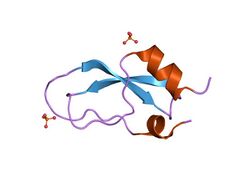Biology:Kunitz domain
| Kunitz/Bovine pancreatic trypsin inhibitor domain | |||||||||||
|---|---|---|---|---|---|---|---|---|---|---|---|
 3D structure of the C-terminal Kunitz domain from human collagen alpha-3(VI) chain.[1] | |||||||||||
| Identifiers | |||||||||||
| Symbol | Kunitz_BPTI | ||||||||||
| Pfam | PF00014 | ||||||||||
| InterPro | IPR002223 | ||||||||||
| PROSITE | PDOC00252 | ||||||||||
| SCOP2 | 5pti / SCOPe / SUPFAM | ||||||||||
| CDD | cd00109 | ||||||||||
| |||||||||||
Kunitz domains are the active domains of proteins that inhibit the function of protein degrading enzymes or, more specifically, domains of Kunitz-type are protease inhibitors. They are relatively small with a length of about 50 to 60 amino acids and a molecular weight of 6 kDa. Examples of Kunitz-type protease inhibitors are aprotinin (bovine pancreatic trypsin inhibitor, BPTI), Alzheimer's amyloid precursor protein (APP), and tissue factor pathway inhibitor (TFPI). Kunitz STI protease inhibitor, the trypsin inhibitor initially studied by Moses Kunitz, was extracted from soybeans.
Standalone Kunitz domains are used as a framework for the development of new pharmaceutical drugs.[2]
Structure
The structure is a disulfide rich alpha+beta fold. Bovine pancreatic trypsin inhibitor is an extensively studied model structure. Certain family members are similar to the tick anticoagulant peptide (TAP, P17726). This is a highly selective inhibitor of factor Xa in the blood coagulation pathways.[3] TAP molecules are highly dipolar,[4] and are arranged to form a twisted two-stranded antiparallel beta sheet followed by an alpha helix.[3]
The majority of the sequences having this domain belong to the MEROPS inhibitor family I2, clan IB; the Kunitz/bovine pancreatic trypsin inhibitor family, they inhibit proteases of the S1 family[5] and are restricted to the metazoa with a single exception: Amsacta moorei entomopoxvirus, a species of poxvirus. They are short (about 50 to 60 amino acid residues) alpha/beta proteins with few secondary structures. The fold is constrained by three disulfide bonds. The type example for this family is BPTI[6] (or basic protease inhibitor), but the family includes numerous other members,[7][8][9][10] such as snake venom basic protease; mammalian inter-alpha-trypsin inhibitors; trypstatin, a rat mast cell inhibitor of trypsin; a domain found in an alternatively spliced form of Alzheimer's amyloid beta-protein; domains at the C-termini of the alpha-1 and alpha-3 chains of type VI and type VII collagens; tissue factor pathway inhibitor precursor; and Kunitz STI protease inhibitor contained in legume seeds.
Drug development
Kunitz domains are stable as standalone peptides, able to recognise specific protein structures, and also work as competitive protease inhibitors in their free form. These properties have led to attempts at developing biopharmaceutical drugs from Kunitz domains. Candidate domains are selected from molecular libraries containing over 10 million variants with the aid of display techniques like phage display,[11] and can be produced in large scale by genetically engineered organisms.
The first of these drugs to be marketed was the kallikrein inhibitor ecallantide, used for the treatment of hereditary angioedema.[11] It was approved in the United States in 2009.[12] Another example is depelestat, an inhibitor of neutrophil elastase that has undergone Phase II clinical trials for the treatment of acute respiratory distress syndrome in 2006/2007[13] and has also been described as a potential inhalable cystic fibrosis treatment.[14]
Examples
Human proteins containing this domain include:
- AMBP, APLP2, APP
- COL6A3, COL7A1, COL28A1
- PAPLN,
- SPINLW1, SPINT1, SPINT2, SPINT3, SPINT4
- TFPI, TFPI2
- WFDC6, WFDC8, WFIKKN1, WFIKKN2
Several plant protease inhibitors of the Kunitz family, the Kunitz-STI protein family, include a beta trefoil fold.[15]
References
- ↑ PDB: 1KTH; "Anisotropic behaviour of the C-terminal Kunitz-type domain of the alpha3 chain of human type VI collagen at atomic resolution (0.9 Å)". Acta Crystallogr. D 58 (Pt 7): 1252–4. July 2002. doi:10.1107/S0907444902007333. PMID 12077460.
- ↑ Nixon, AE; Wood, CR (2006). "Engineered protein inhibitors of proteases". Current Opinion in Drug Discovery & Development 9 (2): 261–8. PMID 16566296.
- ↑ 3.0 3.1 "NMR solution structure of the recombinant tick anticoagulant protein (rTAP), a factor Xa inhibitor from the tick Ornithodoros moubata". FEBS Lett. 352 (2): 251–7. September 1994. doi:10.1016/0014-5793(94)00941-4. PMID 7925983.
- ↑ "Structure of tick anticoagulant peptide at 1.6 A resolution complexed with bovine pancreatic trypsin inhibitor". Protein Sci. 9 (2): 265–72. February 2000. doi:10.1110/ps.9.2.265. PMID 10716178.
- ↑ "Evolutionary families of peptidase inhibitors". Biochem. J. 378 (Pt 3): 705–16. 2004. doi:10.1042/BJ20031825. PMID 14705960.
- ↑ "Crystal structure of a Y35G mutant of bovine pancreatic trypsin inhibitor". J. Mol. Biol. 220 (3): 757–770. 1991. doi:10.1016/0022-2836(91)90115-M. PMID 1714504.
- ↑ Salier JP (1990). "Inter-alpha-trypsin inhibitor: emergence of a family within the Kunitz-type protease inhibitor superfamily". Trends Biochem. Sci. 15 (11): 435–439. doi:10.1016/0968-0004(90)90282-G. PMID 1703675.
- ↑ "Evolutionary origin of a Kunitz-type trypsin inhibitor domain inserted in the amyloid beta precursor protein of Alzheimer's disease". J. Mol. Evol. 34 (6): 536–543. 1992. doi:10.1007/BF00160466. PMID 1593645.
- ↑ "Molecular cloning, expression, and partial characterization of a second human tissue-factor-pathway inhibitor". Proc. Natl. Acad. Sci. U.S.A. 91 (8): 3353–3357. 1994. doi:10.1073/pnas.91.8.3353. PMID 8159751. Bibcode: 1994PNAS...91.3353S.
- ↑ "Amino acid sequence of a protease inhibitor isolated from Sarcophaga bullata determined by mass spectrometry". Protein Sci. 1 (2): 278–288. 1992. doi:10.1002/pro.5560010210. PMID 1304909.
- ↑ 11.0 11.1 Lehmann, A (2008). "Ecallantide (DX-88), a plasma kallikrein inhibitor for the treatment of hereditary angioedema and the prevention of blood loss in on-pump cardiothoracic surgery". Expert Opinion on Biological Therapy 8 (8): 1187–99. doi:10.1517/14712598.8.8.1187. PMID 18613770.
- ↑ Dyax Corp. (2009). "Full prescibing information Kalbitor". http://www.kalbitor.com/pdf/KalbitorFullPrescribingInformation.pdf.
- ↑ Clinical trial number NCT00455767 for "Safety and Efficacy Study of Depelestat in Acute Respiratory Distress Syndrome (ARDS) Patients" at ClinicalTrials.gov
- ↑ Attucci, S; Gauthier, A; Korkmaz, B; Delépine, P; Martino, MF; Saudubray, F; Diot, P; Gauthier, F (2006). "EPI-hNE4, a proteolysis-resistant inhibitor of human neutrophil elastase and potential anti-inflammatory drug for treating cystic fibrosis". The Journal of Pharmacology and Experimental Therapeutics 318 (2): 803–9. doi:10.1124/jpet.106.103440. PMID 16627747.
- ↑ "The plasticity of the β-trefoil fold constitutes an evolutionary platform for protease inhibition". The Journal of Biological Chemistry 286 (51): 43726–34. Dec 2011. doi:10.1074/jbc.M111.291310. PMID 22027836.
 |

